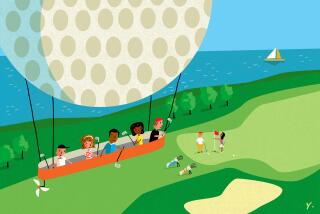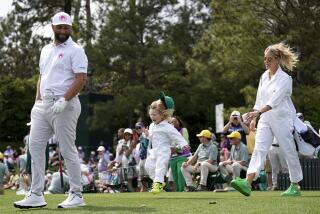Skins Game
It was in 1981 and Jan Stephenson still remembers the pose. She was lying on a bed and her nightgown was slit up one side. It must have been a bit drafty, but Stephenson wore a big smile, if little else.
That was the picture that did it, the one that frosted some of her fellow players, such as Kathy Whitworth and Jane Blalock, even though the photo was for the LPGA’s magazine and sanctioned by its commissioner.
“Jane said to me, ‘Why are you lowering yourself to sell sex?’” said Stephenson, who laughed as she recounted the incident. “Jane asked me recently if I’d consider doing something like that to help her promote the Women’s Senior Golf Tour.”
There is a moral to the story, says Stephenson: “Every single thing is sold with sex, whether you like it or not.”
So it goes on the LPGA Tour, where everything old is new again. While the women’s professional golf organization embarks on an ambitious five-year plan to secure a more favored position in the sports entertainment arena of a People magazine-Entertainment Tonight-Best Damn Sports Show Period money-celebrity-fame crazed society, the main item on the LPGA’s agenda is to make the product more fan-friendly.
And that, you might recall, is where Stephenson came in ... as had Marlene Bauer Hagge and her sister, Alice Bauer, three decades earlier when the LPGA was just beginning. They had part of the equation down pat. They looked terrific--and they could play golf too.
Stephenson says she cannot forget what then-LPGA commissioner Ray Volpe told her about appearing in Fairway magazine in that revealing nightgown.
“He said your golf doesn’t speak for itself,” she said. “If you want to see the best golfers in the world, you would watch the men. If you want to see the best women golfers, then look like women.”
Ty Votaw, current LPGA commissioner, would agree with at least part of what Volpe said long ago. As Votaw points out, most players have historically believed that all that was really required of them--and all that should be required of them--is to play golf to the best of their abilities and everything else would fall neatly in place for the benefit of the LPGA.
“Our fans are telling us that that’s not the case, that they have to do more than just play great golf,” Votaw said.
As a part of the first, long-range strategic planning session in its 52-year history, the LPGA identified several short-term goals to promote the sport. The LPGA wants to increase television viewership 10% each year of the five-year plan and also wants to boost tournament attendance by 15% each year.
Of the 31 events on this year’s schedule, 25 offer at least $1 million in prize money, 13 more than two years ago. Votaw’s goal for 2003 is that every tournament has a purse of at least $1 million.
What Votaw came up with is something called the “Five Points of Celebrity,” as outlined in his five-year plan, which he revealed to the LPGA members in a players-only summit nearly a month ago in Phoenix.
Performance is the first point and is the key, said Votaw, but it cannot be the only factor and must be considered along with the other four: approachability, joy and passion, relevance and appearance.
Appearance? It’s not just ironing golf shirts and shining your shoes; it’s Grace Park revealing her navel when she swings or Carin Koch’s short shorts or Jill McGill’s legs. And is that bad? Not anymore, apparently.
“I don’t see anything wrong with it,” said Juli Inkster, 41 and a mother of two girls. “When I go out, I watch the best-looking guy players. It’s like, if you’ve got it, you’ve got it.
“If you’ve got the body to do it, go for it. I wish I did. Remember this: We’re still in the entertainment business.”
Or, as Votaw said, “Right or wrong, society has decided that it’s important to be attractive, [and] if we’re just about being pro golfers, then our players will not reach their potential.”
Annika Sorenstam is a great player but not particularly outgoing. She said she would do her best to try to improve but that she will not and cannot be anyone but herself. Votaw said he does not ask that of any player, least of all Sorenstam, his top card.
Said Votaw: “I’m not asking for contrived fist pumps.” He said he told the players at the summit that they all embody the five points, that some are stronger in some areas than others. Those five points are “critical for our young players in order to become more marketable,” he said.
The players seem to be very much on board the ship Votaw is sailing, and he’s got their full attention. They sign more autographs, they do more print and television interviews. Michelle McGann was nearly in the locker room after shooting an 84 during the Kraft Nabisco Championship before a Palm Springs TV reporter asked her to return to the scoring area for an interview. She complied, with a smile.
ESPN is the major television carrier of the LPGA Tour, and the network’s director of programming, Kelly LaFerriere, isn’t sure simply emphasizing sex appeal is the way to go.
“I think we’re committed to build stars based on their athletic ability,” she said. “I think whether it’s male or female sports, we need to focus on athletic ability and the stories behind the athletes to build recognition.”
In golfer Helen Alfredsson’s opinion, revealing something of yourself in an interview--providing material for the kinds of stories LaFerriere is talking about--is as vital as revealing something of yourself with your choice of wardrobe. Say something interesting, not necessarily what iron you hit to the green or how your putting is going, she said.
“You don’t have to say who you’re sleeping with,” said Alfredsson, 36. “Most of the things I hear our players say in interviews is so boring, I want to go to sleep.”
It’s possible we’re seeing a honeymoon period between the players and the media, but even if that’s true, many players are not the least bit reluctant to speak out about the sensitive issue of how you look.
“You’re not going to stop Madison Avenue,” said Amy Alcott, 46. “Sex sells. That’s not exactly a bulletin. Now, I don’t think it should be the only focal point. Look, if you’re an attractive woman golfer, there’s nothing wrong with it. If you have the combination and it works, fine.
“Lots of times there were players bending over in their skirts and their pictures were on the front page and I would say to myself, ‘Amy, don’t worry about that. Let your clubs do the talking.’ Like I say, there’s nothing wrong with selling sex on the tour, but it can’t be the focal point or you’re setting the tour back.”
The LPGA seems to be positioned somewhere between the WNBA and the Women’s Tennis Assn., when it comes to marketing its players.
It’s only six years old, but the WNBA has made its mark as a grass-roots league with a solid fan-friendly base. The league estimates that 28% of its arena audience is under 18 and that 78% of that sample is female.
“You market to women differently than men,” said Traci Cook, senior director for corporate communications for the WNBA.
“Our fans, young girls and older women, often their moms, they like to look at the whole person. Like, what do they look like when they’re not playing. What do they look like in clothes?
“Women like to see what other women wear. And a lot of our players like to dress up.”
Unlike tennis or even golf, where players choose their own clothes, women’s professional basketball players play their games in uniforms. As Cook said, there is only one place to see how they look in normal clothes.
“Women and young girls want to see them off the court,” she said. “And anyone who is representing the corporate community, you want them to look appropriate.”
But there is always room for self-expression, which helps marketing the WNBA as well, Cook said. In the April issue of Self magazine, Lisa Leslie of the Sparks, the league’s most valuable player, is photographed in a swimsuit at a spa.
Meanwhile, women’s tennis is nowhere near as subdued in the marketing of its athletes.
For instance, tennis professional Vanessa Menga, 25, recently posed for a pictorial in the Brazilian edition of Playboy. Menga is ranked No. 394 in the world.
“Today’s fans expect athletes to be more than athletic,” Jim Fuhse, director of player promotions for the WTA, said in the book about the women’s tour called “Venus Envy.”
“We’re never going to stop selling sex.”
In that case, women’s tennis has the best opportunity, since players are free to wear as little as they dare. Anna Kournikova has not won a tournament, but she’s a champion in marketing products and has used her allure to become the top pitchman in the sport.
Each year, the WTA prints a calendar with photos of its top players. However, Chris DeMaria, vice president of communications of the WTA Tour, says no one is being forced to look or act in any way she doesn’t want.
“We’re not asking them to do bikini shots,” DeMaria said. “I don’t think it hurts at all to be physically attractive and be a top player. We don’t tell our players how to dress. We have some who aren’t into the fashion side, frankly. You wear what you want to wear.
“Some players, like Venus [Williams] and Serena [Williams], they are both fashion students, and their sponsors ... can be more on the cutting edge with them.”
The same was true last year at the U.S. Open, where Ashley Harkleroad wore clothes that were obviously very progressive and revealing and worked for her.
Harkleroad, 16, caused a sensation when she wore very tight shorts and a midriff-baring top, although she lost in the first round. At Wimbledon, she won the girls’ doubles title with Argentina’s Gisella Dulko.
“I think it’s good for the game if you have a well-rounded package, that you’re physically attractive and a great player,” DeMaria said. “If you have that combination, you can market it.
“We don’t oversell it, though. And I do have to applaud the LPGA for going in that direction. That’s going to help their sport.”
Donna Lopiano of the Women’s Sports Foundation says the LPGA’s five points of celebrity have been standard in media training for athletes for decades, though she questions the focus on one particular issue.
“I think the media is obsessed with stereotype appearances,” Lopiano said. “Who cares what a [PGA Tour] guy wears? A shirt with a collar and a pair of slacks. Women golfers dress on the range of that, to absolute fashion. I think the women on tour have a much tougher time dressing.
“At the Academy Awards, nobody gives a worst-dressed award to a guy. He’s in a tux. Women, it’s entirely different.”
Lopiano also said that if the LPGA is marketing sex appeal, it may be in over its head.
“You’re talking about well-traveled, professional, public figures and impressions and appearances are very important.”
Golfer Kris Tschetter says she feels comfortable with the way she is perceived, which is as one of the most attractive women on the LPGA Tour. She made the list that Playboy.com included in an on-line poll of which players the readers would most like to see without golf clothes.
Tschetter, 37 and married, enjoys the celebrity aspect of her job.
“I do know that it’s hard for some people to be approachable,” she said. “You try to look your best. Maybe there’s a handful of players who don’t want to agree with that, for whatever reasons.
“If you’ve got a good body, let’s face it, your approval rating goes up.... It’s the same with any guy. If a guy is good-looking, his approval rating goes up. Maybe it’s not fair, but you can’t ignore it.”
Tschetter says it’s harder for golfers to look great in comparison to other female athletes because they’re generally older.
“Every other sport just about has teenagers playing their games, and they look great,” she said. “People don’t get to be 35 and play except in this sport. But I won’t go so far as to call it ‘sex appeal.’ It has to be ‘appeal.’
Lorie Kane, 37, says she wants to be referred to as an athletic person who plays golf. She agrees with what Votaw has been saying, that if the primary focus of the new LPGA’s plan is on sex appeal, “that doesn’t last very long.”
McGill, a 6-foot USC graduate, is 30 and enjoys skiing, piano, tennis, movies, throwing darts, singing in the shower, jumping over rose gardens and dancing. Posing for Playboy might be next, although she isn’t saying. Koch won the Internet poll and isn’t interested in posing for the magazine; runner-up McGill is still considering it. “I’m not automatically ruling it out,” she said.
That’s a wise move, says Stephenson, who talked with McGill last week about the Playboy offer. “Jill asked me if it would hurt the LPGA and I said, ‘Don’t be silly. It’s a five-day shoot and it’s going to make you famous.’” Now 50, Stephenson doesn’t play as many LPGA events as she used to, only 19 in 2001, but she will tee it up this week at the Office Depot Championship at El Caballero and continue her work as honorary chairman of the National Multiple Sclerosis Society.
Stephenson never appeared in a Playboy pictorial, though she says she turned down a $150,000 offer. But she did pose for a series of provocative photos for calendars as a promotion for Dunlop.
The most famous is of Stephenson sitting in a giant tub of golf balls. She says she was clothed in the tub, but only slightly, wearing “two little round things and a little triangle.” More than 250,000 copies of that calendar were sold with the proceeds going to charity.
“Back then, Volpe figured things like that were worth 25,000 extra people a day in the gallery,” Stephenson said. “I have no doubt it was all true.”
The LPGA, taking from its past and looking toward its future, has its five-year strategic plan in place. It’s going to take at least that long to figure out what’s gone right, or wrong.
Times staff writer Larry Stewart contributed to this report.
More to Read
Go beyond the scoreboard
Get the latest on L.A.'s teams in the daily Sports Report newsletter.
You may occasionally receive promotional content from the Los Angeles Times.










